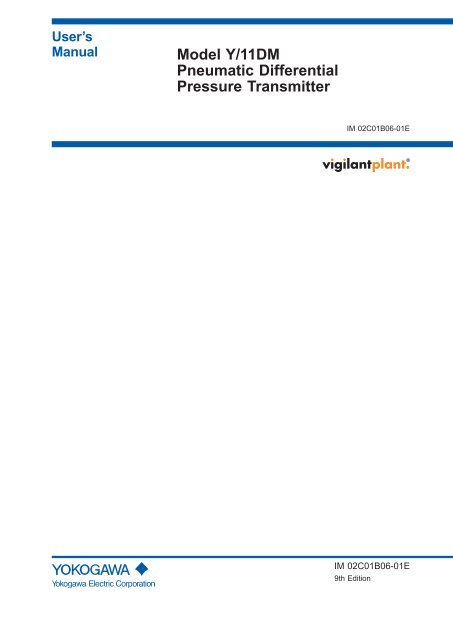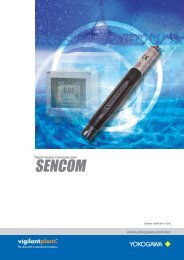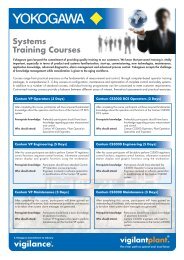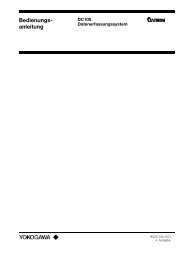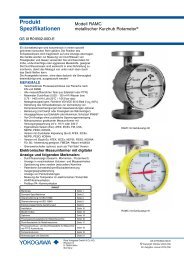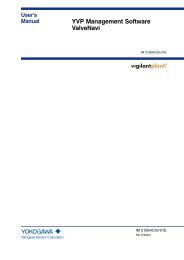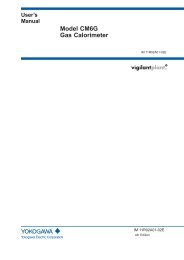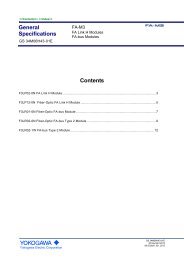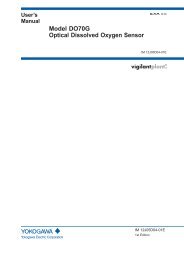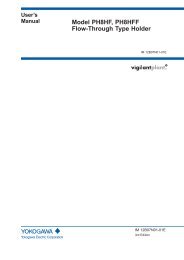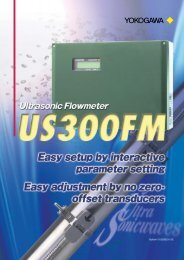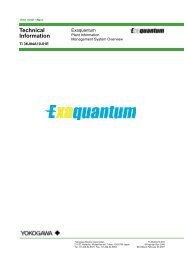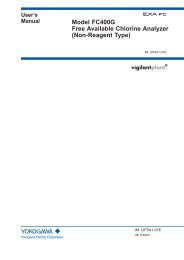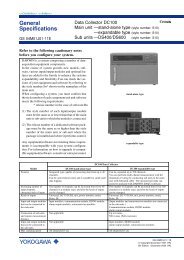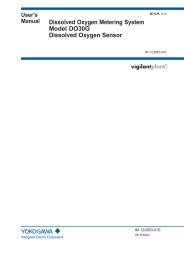Model Y/11DM Pneumatic Differential Pressure ... - Yokogawa
Model Y/11DM Pneumatic Differential Pressure ... - Yokogawa
Model Y/11DM Pneumatic Differential Pressure ... - Yokogawa
You also want an ePaper? Increase the reach of your titles
YUMPU automatically turns print PDFs into web optimized ePapers that Google loves.
iiAppendix 1.5.9.1 Dashpot Removal...............................................................................5-75.9.2 Dashpot Alignment.............................................................................5-75.9.3 To Remove Feedback Bellows and Zero Spring(behind Zero Screw)...........................................................................5-85.9.4 To Remove Back Flexures.................................................................5-85.9.5 To Remove Force Balance Unit.........................................................5-85.9.6 To Remove Relay Mounting Assembly.............................................. 5-85.9.7 To Remove Front Flexure...................................................................5-85.9.8 To Remove Force Bar........................................................................5-95.9.9 Static Alignment..................................................................................5-95.9.10 Flapper Alignment............................................................................5-105.9.11 Bolt Tightening Procedure - Force Balance Unit.............................5-1080A <strong>Pneumatic</strong> Amplifier (Part No. F9138YA)..........................A-1A1.1 Principles of Operation.................................................................................... A-1A1.2 Cleaning the <strong>Pneumatic</strong> Amplifier.................................................................. A-1A1.3 Calibration Procedure using Calibrating Fixture.......................................... A-2Customer Maintenance Parts List<strong>Model</strong> Y/<strong>11DM</strong> PNEUMATIC DIFFERENTIAL PRESSURETRANSMITTER (Style C)....................................................................CMPL 02C01B06-01EIM 02C01B06-01E
1-11. IntroductionThank you for purchasing the <strong>Yokogawa</strong>’sinstrument.The instrument is correctly calibrated at the factorybefore shipment. To ensure correct and efficientuse of the instrument, please read this manualthoroughly and fully understand how to operate theinstrument before operating it.• Regarding This Manual• This manual should be provided to the enduser.• The contents of this manual are subject tochange without prior notice.• All rights reserved. No part of this manual maybe reproduced in any form without <strong>Yokogawa</strong>’swritten permission.• <strong>Yokogawa</strong> makes no warranty of any kind withregard to this material, including, but not limitedto, implied warranty of merchantability andfitness for a particular purpose.• If any question arises or errors are found, or ifany information is missing from this manual,please inform the nearest <strong>Yokogawa</strong> salesoffice.• The specifications covered by this manual arelimited to those for the standard type under thespecified model number break-down and do notcover custom-made instrument.• Please note that changes in the specifications,construction, or component parts of theinstrument may not immediately be reflectedin this manual at the time of change, providedthat postponement of revisions will not causedifficulty to the user from a functional orperformance standpoint.• Safety Precautions• For the protection and safety of the operatorand the instrument or the system includingthe instrument, please be sure to follow theinstructions on safety described in this manualwhen handling this instrument. In case theinstrument is handled in contradiction to theseinstructions, <strong>Yokogawa</strong> does not guaranteesafety.• <strong>Yokogawa</strong> assumes no responsibilities for thisproduct except as stated in the warranty.• If the customer or any third party is harmed bythe use of this product, <strong>Yokogawa</strong> assumesno responsibility for any such harm owing toany defects in the product which were notpredictable, or for any indirect damages.• The following safety symbols are used in thismanual:WARNINGIndicates a potentially hazardous situation which,if not avoided, could result in death or seriousinjury.CAUTIONIndicates a potentially hazardous situation which,if not avoided, may result in minor or moderateinjury. It may also be used to alert against unsafepractices.IMPORTANTIndicates that operating the hardware or softwarein this manner may damage it or lead to systemfailure.NOTEDraws attention to information essential forunderstanding the operation and features.IM 02C01B06-01E
1-21.1 Safety PrecautionsWARNING• Instrument installed in the process is underpressure. Never loosen or tighten theprocess connector bolts as it may causedangerous spouting of process fluid.• During draining condensate or venting gasin transmitter pressure-detector section, takeappropriate care to avoid contact with theskin, eyes or body, or inhalation of vapors, ifthe accumulated process fluid may be toxicor otherwise harmful.Since draining condensate or bleedingoff gas gives the pressure measurementdisturbance, this should not be done whenthe loop is in operation.• If the accumulated process fluid may betoxic or otherwise harmful, take appropriatecare to avoid contact with the body, orinhalation of vapors even after dismountingthe instrument from process line formaintenance.IMPORTANT• Supply air must be clean and dry.- Supply air (pressurized) must not bedewed event at -40°C.- Air filter with 5μm (0.0002 inch) of filterelement maximum opening shall berecommended.- Oil filter should be provided to remove oilin the supply air.• Maximum supply air pressure of transmitterwithout fixed pressure regulator (GAS orNAS type) is 215 kPa. Should the pressureexceed 215 kPa, it is possible to break thepneumatic amplifier, bellows etc.• When weling piping during construction, takecare not to allow welding currents to flowthrough the transmitter.• Do not step on this instrument afterinstallation.• Applying a leakag-detecting fluid to theinstrument may damage the plastic partsresulting from corrosion or cracking.1.2 Warranty• The warranty shall cover the period noted onthe quotation presented to the purchaser at thetime of purchase. Problems occurred during thewarranty period shall basically be repaired freeof charge.• In case of problems, the customer shouldcontact the <strong>Yokogawa</strong> representative fromwhich the instrument was purchased, or thenearest <strong>Yokogawa</strong> office.• If a problem arises with this instrument,please inform us of the nature of the problemand the circumstances under which itdeveloped, including the model specificationand serial number. Any diagrams, data andother information you can include in yourcommunication will also be helpful.• Responsible party for repair cost for theproblems shall be determined by <strong>Yokogawa</strong>based on our investigation.• The Purchaser shall bear the responsibility forrepair costs, even during the warranty period, ifthe malfunction is due to:• Improper and/or inadequate maintenance bythe Purchaser.• Failure or damage due to improper handling,use or storage which is out of designconditions.• Use of the product in question in a locationnot conforming to the standards specifiedby the <strong>Yokogawa</strong>, or due to impropermaintenance of the installation location.• Failure or damage due to modification orrepair by the party except <strong>Yokogawa</strong> or whois requested by <strong>Yokogawa</strong>.• Malfunction or damage from improperrelocation of the product in question afterdelivery.• Reason of force majeure such as fires,earthquakes, storms/floods, thunder/lightening, or other natural disasters, ordisturbances, riots, warfare, or radioactivecontamination.IM 02C01B06-01E
2. General2.1 Outline<strong>Model</strong> Y/<strong>11DM</strong> <strong>Differential</strong> <strong>Pressure</strong> Transmitter is aforce-balance instrument that measures differentialpressure and transmits it as a proportional 0.2 to1.0 kgf/cm 2 or bar, 20 to 100kPa, or 3 to 15 psi airsignal. 2-12.2 Principle of OperationThe high and low pressures are connected toopposite sides of a bellows capsule. The resultingdifferential pressure exerts a force on the capsulewhich is applied to the lower end of the force bar.The metal diaphragm serves as both a fulcrumfor the force bar and as a closure-seal for the lowpressure chamber. The force is transmitted throughthe flexure connector to the range bar, which pivotson the range adjustment wheel.Any movement of the range bar causes a minutechange in the clearance between the flapper andnozzle. This produces a change in the outputpressure from the amplifier to the feedback bellowsuntil the force in the bellows balances the force onthe capsule.Figure 2.1OutlineF0201.aiThe output pressure, which is established by theforce-balance, is the transmitted pneumatic signalwhich is proportional to the differential pressure.This signal is transmitted to a pneumatic receiver torecord, indicate, and/or control.HighpressureconnectionReducingtubeFlappernozzleassemblyFlexureconnectorForce barDiaphragmsealLowpressureconnectionAirsupply<strong>Pneumatic</strong>amplifierOutputRange wheelRange barFeedbackbellowsZeroadjustmentscrewBellowscapsuleFlexureF0202.aiFigure 2.2Principle of OperationIM 02C01B06-01E
2.3 Standard SpecificationsSpan Limits:Refer to Table 2.1.Span is continuously adjustable within rangelimits.Range Limits *:Refer to Table 2.1.*: When lower range-value is other than zero,optional kit for elevated-zero or suppressedzeroranges is installed.Static <strong>Pressure</strong> Limits:Refer to Table 2.1.Output Signal:20 to 100 kPa.Accuracy (includes linearity, hysteresis andrepeatability):±0.5 % of span.Repeatability:0.1% of span.Dead Band:0.05% of span.Air Supply <strong>Pressure</strong>:140 kPa, 1.4 kgf/cm 2 or bar, or 20 psi.Air Consumption:0.5 m 3 /h at 0 °C, 101.3 kPa {1.033 kgf/cm 2 }absolute (0.3 scfm).Ambient Operating Temperature Range:-40 to 120 °C (-40 to 250 °F).Process Temperature Limits:-40 and 120 °C (-40 and 250 °F) at capsule.Mounting:Bracket for nominal 50 mm (2 inches) horizontal orvertical pipe.Table 2.1. Span, Range and Static <strong>Pressure</strong> Limits. 2-2Air Connection:Tapped for JIS R1/4 or 1/4NPT, whicheverspecified.Process Connection:JIS Rc1/2, Rc1/4, 1/2NPT, or 1/4NPT female,whichever specified.Wetted Parts Material:Body: Forged JIS SUS 316 stainless steel.Bellows Capsule: SUS 316L stainless steel.Force Bar: SUS 316 stainless steel.Force Bar Seal: Cobalt-nickel alloy.Capsule Gasket: Silicone elastomer.Force Bar Seal Gasket: Silicone elastomer.Connection Hardware:JIS SCM435 chrome-molybdenum steel capscrews and nuts through body and processconnection block.Cover:Cast aluminum, finished with gray polyurethanepaint. Gasketed for National ElectricalManufacturers Association (NEMA) (USA) Type 3weatherproof service.Approximate Weight:5.4 kg (12 lb).BCDECapsule – M-calibration P-calibration bar-calibrationSpan Limits 0.14 to 1.4 MPa 1.4 to 14 kgf/cm 2 20 to 200 psi 1.4 to 14 barRange Limits -1.7 to 2.4 MPa -17 to 24 kgf/cm 2 -250 to 350 psi -17 to 24 barS. P. Limits 2.4 MPa 24 kgf/cm 2 350 psi 24 barSpan Limits 0.28 to 2.7 MPa 2.8 to 28 kgf/cm 2 40 to 400 psi 2.8 to 27 barRange Limits -3.5 to 5.1 MPa -35 to 52 kgf/cm 2 -500 to 750 psi -35 to 51 barS. P. Limits 5.1 MPa 52 kgf/cm 2 750 psi 51 barSpan Limits 0.7 to 6.8 MPa 7 to 70 kgf/cm 2 100 to 1000 psi 7 to 68 barRange Limits -10 to 10 MPa -105 to 105 kgf/cm 2 -1500 to 1500 psi -100 to 100 barS. P. Limits 10 MPa 105 kgf/cm 2 1500 psi 100 barSpan Limits 1.4 to 13.7 MPa 14 to 140 kgf/cm 2 200 to 2000 psi 14 to 137 barRange Limits -14 to 14 MPa -140 to 140 kgf/cm 2 -2000 to 2000 psi -140 to 140 barS. P. Limits 14 MPa 140 kgf/cm 2 2000 psi 140 barOutput Signal 20 to 100 kPa 0.2 to 1.0 kgf/cm 2 3 to 15 psi 0.2 to 1.0 barOption CodeStandardSpecificationsCAL-M CAL-E CAL-BIM 02C01B06-01E
2-32.4 <strong>Model</strong> and Suffix Codes<strong>Model</strong> Suffix Codes DescriptionY/<strong>11DM</strong> . . . . . . . . . . . . . . <strong>Pneumatic</strong> differentialpressure transmitter.BellowsCapsuleBodyMaterial *1ProcessConnection-B . . . . . . . . . . . . B capsule.Span:0.14 to 1.4 MPa-C . . . . . . . . . . . . C capsule.Span:0.28 to 2.7 MPa-D . . . . . . . . . . . . D capsule.Span:0.7 to 6.8 MPa-E . . . . . . . . . . . . E capsule.Span:1.4 to 13.7 MPaS . . . . . . . . . . Forged JIS SUS 316stainless steel.1 . . . . . . . .2 . . . . . . . .3 * 2 . . . . . .4 * 2 . . . . . .Options / /JIS Rc 1/4 female.JIS Rc 1/2 female.ANSI 1/4 NPT female.ANSI 1/2 NPT female.*1: Users must consider the characteristics ofselected wetted parts material and the influenceof process fluids. The use of inappropriatematerials can result in the leakage of corrosiveprocess fluids and cause injury to personnel and/or damage to plant facilities. It is also possible thatthe diaphragm itself can be damaged and thatmaterial from the broken diaphragm and the fillfluid can contaminate the user’s process fluids.Be very careful with highly corrosive processfluids such as hydrochloric acid, sulfuric acid,hydrogen sulfide, sodium hypochlorite, and hightemperaturesteam (150 ºC [302 ºF] or above).Contact <strong>Yokogawa</strong> for detailed information of thewetted parts material.*2: Air connections, drain plug connection are also tappedfor ANSI NPT threads in addition to the processconnection.2.5 OptionsAir Set:Fixed combination pressure regulator and filterwith 35 mm diameter pressure gauge mountedand piped to transmitter. Also available withoutgauge.Supply pressure: 0.2 to 1 MPa, 2 to 10 kgf/cm 2or bar, or 30 to 150 psi.Output pressure: 140 kPa, 1.4 kgf/cm 2 or bar, or20 psi.Maximum operating temperature : 80 °C (180°F).Air Connection Gauge Scale Option CodeJIS Rc 1/4female1/4 NPT female0 to 200 kPa0 to 2 kgf/cm 20 to 30 psi0 to 2 barWithout gauge0 to 200 kPa0 to 2 kgf/cm 20 to 30 psi0 to 2 barWithout gaugeGAS-FPGAS-FMGAS-FEGAS-FBGAS-FNAS-FPNAS-FMNAS-FENAS-FBNAS-FKit for Elevated-Zero or Suppressed-ZeroRanges:Permits adjustments to 1100 % of minimum spanand to range limits of capsule. Upper range-valuemust not exceed upper range-limit of capsule.Option code: R-kit for suppressed-zero rangesand L-kit for elevated-zero ranges.Low Spans:Refer to Table 2.2. Accuracy ±0.5 % of span. (Add0.5 % with Suffix Code R or L)Option code: LD.Cover Color Other Than Standard Finish:Specify in color block □ by color code.Refer to GS 22D1F1-E.Option code: SCF-□.Stainless Steel Hardware:JIS SUS 630 cap screws and nuts through bodyand process connection block.Option code: SSB.Oxygen Service Preparation:Degrease cleansing treatment.Option code: OSW.Calibration Units:M-calibration (Unit: kgf/cm 2 ) Option code: CAL-MP-calibration (Unit: psi) Option code: CAL-Ebar-calibration (Unit: bar) Option code: CAL-BTable 2.2. Low SpansSpanCapsulekPa kgf/cm 2 psiB 70 to 700 0.7 to 7 10 to 100C 140 to 1350 1.4 to 14 20 to 200D 350 to 3400 3.5 to 35 50 to 500E 700 to 6800 7 to 70 100 to 1000IM 02C01B06-01E
2-42.6 Dimensions118Allow clearance 150 mmfor cover removal11025.4Unit : mmAir supply connection(without air supply set)Output connection193Air supply set(option)Allow clearance150 mm for zeroadjustmentAir supply gauge(option)SUP OUT6537055Low pressureconnectionAir supply connection(with air supply set)High pressure connectionDrain plug13038 59Nominal 50 mm (2 inches) pipevertical or horizontal(supplied by user)68949351127F0203.aiIM 02C01B06-01E
3-13. Installation3.1 Transmitter MountingTransmitter may be mounted in any position.After transmitter is mounted, tighten all bolts.Pipe may be clamped to another pipe, or flangedand bolted to floor or wall.U-bolt secures assembly to 2" pipe. U-bolt may berevolved 90° for use with horizontal pipe.For fixed regulator and associated parts, refer toCustomer Maintenance Parts List involved.Optional air-set can be mounted as illustratedbelow.3.2 Air Supply and TransmissionPipingTransmitter1/4" (8A) TubingOutput gaugeSupply gauge(optional)Shut off valveAir supplyAir filter-regulator (optional)ReceiverF0303.aiFigure 3.3Air Supply and Transmission PipingU-bolt2" PipeEither set ofmounting holesmay be used.BoltNOTE• Air supply must be regulated at 1.4 kgf/cm 2or bar, 140 kPa, or 20 psi.• Transmitter uses 0.5 Nm 3 /h of air in normaloperation.• Air must be clean and dry. Blow out filterregularly.• Transmission line must be free of leaks.F0301.aiFigure 3.1Transmitter MountingLowpressureHighpressureBypassF0302.aiFigure 3.2Typical Transmitter PipingIM 02C01B06-01E
4. Operation4.1 Zero Adjustment4.1.1 WITHOUT Zero Elevation or ZeroSuppression Kit.Make adjustment with transmitter in operatingposition.1. Disconnect line to receiver. Connect 0-1.5kgf/cm 2 or bar, 0-150kPa, or 0-22 psi pressuregauge to OUT connection. 4-14.1.2 WITH Zero Elevation or ZeroSuppression Kit.Make adjustment with transmitter in operatingposition.1. Disconnect line to receiver. Connect 0-1.5kgf/cm 2 or bar, 0-150kPa, or 0-22 psi pressuregauge to OUT connection.Air supplyLow pressure lineHighpressure lineAir supplyBypass valve<strong>Pressure</strong>gaugeF0401.ai2. Adjust air supply to pressure at whichtransmitter will be operated.3. Close both pressure connection valves, andopen bypass valve. Slowly open high pressureconnection valve to apply static pressure toboth sides of transmitter.4. Adjust zero screw so that pressure gauge reads0.2kgf/cm 2 or bar, 20 kPa, or 3 psi.<strong>Pressure</strong>gaugeF0403.ai2. Adjust air supply to pressure at whichtransmitter will operate.3. For suppressed-zero ranges: Close bypassvalve. Apply pressure equal to amount of zerosuppression to high pressure side. Vent other side.For elevated-zero ranges: Close bypassvalve. Apply pressure equal to amount of zeroelevation to low pressure side. Vent other side.4. Adjust screw so that pressure gauge reads 0.2kgf/cm 2 or bar, 20 kPa or 3 psi.Zero adjustmentscrewAdjustmentscrewF0402.ai5. Reconnect OUT piping. If necessary, changezero adjustment on receiver so that readingis zero. Close bypass valve and open lowpressure connection valve. Transmitter is nowin operation.F0404.aiIllustrated is transmitter with zero suppressionkit. If transmitter has zero elevation kit,adjustment screw is on opposite side.5. Reconnect OUT piping. If necessary, changezero adjustment on receiver so that it readszero. Open bypass valve, then open pressureconnection valves. Close bypass valve.Transmitter is now in operation.IM 02C01B06-01E
5-25.1.2 Calibration ProceduresStep 2, 4, and 5 in procedure below pertain onlyto transmitters with zero suppression or zeroelevation kit. Illustrations for these steps show zerosuppression kit. If transmitter has zero elevationkit, location of the 2 screws mentioned is reversed.If transmitter has neither zero suppression kit norzero elevation kit, omit these steps.1. Set up calibration equipment (Refer to section5.1.1). Check overrange stop adjustment (Referto section 5.1.5).2. If transmitter has elevated or suppressed-zerorange, disconnect spring from force bar asfollows:A. Remove screw from end of spring.4. With elevated or suppressed-zero range, setcalibrating pressure equal to lower differentiallimit.CalibratingpressureF0504.ai5. Turn adjustment screw so that output is 0.2 kgf/cm 2 or bar, 20 kPa, or 3 psi.BracketAdjustmentscrewF0505.aiB. Turn adjustment screw clockwise until springis clear of bracket.Spring must not bind against flapper or casting.F0502.ai3. With no differential pressure on transmitter,adjust zero screw so that output reads 0.2 kgf/cm 2 or bar, 20 kPa, or 3 psi.If screw was removed in Step 2-A, replace it.6. Set calibration pressure equal to upperdifferential limit. Output should be 1.0 kgf/cm 2 orbar, 100 kPa, or 15 psi.7. If output is incorrect, loosen locknut and adjustrange wheel for correct output. Turning rangewheel down increases output. Retighten locknutafter each adjustment.RangewheelLocknutF0506.aiZero adjustment screwF0503.ai8. Repeat Steps 3 through 7 until desiredaccuracy is obtained.Tighten range wheel locknut securely.9. Make zero adjustment (Refer to section 4.1).IM 02C01B06-01E
5-35.1.3 To Change Range of TransmitterThe transmitter range may be changed within thelimits of the capsule by adjusting the span and zeroadjustments. If the desired range is outside thelimits of the capsule installed in the transmitter, adifferent capsule is required. Refer to section 2.3(Table 2.1) for the span and pressure limits for thevarious capsules.• Capsule IdentificationCapsules can be identified by the designation(B, C, D, or E) stamped on their faces, or by thedimensions indicated below.Note: Styles A and B transmitters cannot use Style C transmittercapsules.5.1.4 Flexure Cap Screw AdjustmentIf bellows capsule was removed or flexure capscrew loosened, before calibrating, adjust capscrew as follows:Zero AdjustmentScrewHex-key wrenchF0509.aidFigure 5.3Flexure Cap Screw AdjustmentStyles A and BStyle CdF0508.aiF0507.aiDimension Capsule Designationd (mm) Style C Styles A & B13 B A10 C B6 D C4 E DFigure 5.2 Capsule Identification1. Set up the calibration equipment (Refer tosection 5.1.1).2. If transmitter has zero elevation or zerosuppression kit, disconnect spring from forcebar (Refer to Step 2 of section 5.1.2).3. Vent pressure signals to transmitter.4. Remove bottom plug.5. Insert a 9/64" hex-key wrench and loosenflexure cap screw.6. Adjust zero screw so that output is 0.2 kgf/cm 2or bar, 20 kPa, or 3 psi.7. Carefully tighten flexure cap screw and observeoutput.If output changes less than 0.014 kgf/cm 2 orbar, 1.4 kPa, or 0.2 psi, adjust zero screw sothat output is 0.2kgf/cm 2 or bar, 20kPa, or3psi. Replace bottom plug, and proceed withcalibration.If output change exceeds 0.014 kgf/cm 2 or bar,1.4 kPa, or 0.2 psi, repeat Steps 5, 6, and 7.If change persists, check capsule installation(Refer to section 5.6), then repeat Flexure CapScrew Adjustment.IM 02C01B06-01E
5-45.1.5 Overrange Stop AdjustmentThe overrange stop prevents damage to both theflapper-nozzle and the dashpot. Before calibrating,check that the stop is correctly adjusted.IMPORTANT5.2 Supply Air FilterNever move the force bar if the overrange stop isloose or disconnected.1. Turn on air supply. Apply pressure to highpressureside so that output is stabilized at avalue between 0.2 and 1.0 kgf/cm 2 or bar, 20and 100 kPa, or 3 and 15 psi.2. Clearance between both sides of overrangestop (U-shaped bracket) and plate to besufficient to permit sliding piece of paperbetween them.3. If not, loosen screws with 3/32" hex-key wrenchand reposition stop to get correct clearance.Retighten screws.Overrange stopF0512.aiBlow filter out at least once a day.Figure 5.4 Air Filter5.3 To Clean RestrictorA plugged restrictor will cause low output pressure.AmplifierTweezersScrewWirePrior to August, 1975 restrictorwas screwed into side of casting.O-ringF0513.aiF0510.ai4. With zero elevation kit, loosen lockscrew with3/32" hex-key wrench. Hold eccentric pin incorrect position with opened wrench and tightenlockscrew.Overrange stopFigure 5.5Cleaning of Restrictor1. Remove amplifier (Refer to section 5.8).2. Lift out restrictor with tweezers.3. Clean with a 0.18 mm dia. wire.4. Apply thin film of Vaseline, or similar lubricant toO-ring.4.Transmitter withzero elevation kitTransmitter withzero suppression kitF0511.aiIM 02C01B06-01E
5-55.4 To Clean Nozzle AssemblyAn accumulation of dirt at the flapper nozzle maycause a zero shift.5.5 To Remove Bellows CapsuleNozzle assemblyNozzle nutCapsuleNozzleClamp screwCap screwBottomplugF0516.aiFigure 5.7Remove Bellows CapsuleFeedback O-ring connectionNozzle O-ring connectionFigure 5.6 Cleaning of Nozzle AssemblyF0514.ai1. Remove bottom plug.2. Remove cap screw using 9/64" hex-keywrench. This will free capsule from bottom offorce bar.3. Disassemble remaining parts as shown.1. Unscrew nozzle nut. Do not let soldered nut onopposite side of casting turn.2. Ease nozzle out of casting.3. Loosen clamp screw and rotate S-clamp.Withdraw nozzle O-ring connection with twistingmotion. Do not bend tubing.4. Clean nozzle with 0.73 mm dia. wire,compressed air, or suitable solvent. Wipe top offlapper clean.WireO-ringF0515.ai5. Before replacing, apply a thin film of Vaselineor similar lubricant to O-ring. Replace nozzleassembly in reverse order. Check referenceadjustment (Refer to section 4.1).IM 02C01B06-01E
5-65.6 To Replace Bellows CapsuleWhen capsule is replaced, use new O-rings.O-ring5.7 To Clean or Replace ScreensIf fine screen air filters become clogged,remove with pointed tool and replace.Spacer fits in lowpressure side.Connection blockCap screwCapsuleF0517.aiRemove coarse screen filters withpointed tool for cleaning or replacement.F0519.aiFigure 5.9Clean or Replace ScreensForce barFlexureWasherCap screw9/64" WrenchF0518.aiFigure 5.8 Replace the Bellows Capsule5.8 To Remove <strong>Pneumatic</strong>AmplifierTo remove pneumatic amplifier, remove 2 largescrews and pry off. A gasket is furnished with eachreplacement amplifier.When replace the pneumatic amplifier, tighten thescrews by the torque of 1.6 to 1.8 N·m (16 to 18kgf·m).For servicing details, refer to Appendix 1.Screw1. Lubricate O-rings with a thin film of Vaseline orsimilar lubrication, and position in grooves inconnection block and body.2. Insert capsule with flexure horizontal againstbottom of force bar.3. Loosely screw cap screw into force bar to clampflexure lightly.4. Position connection block over bolts and tightennuts gradually to 55 N·m torque.5. Tighten flexure against bottom of force bar asdescribed in Flexure Cap Screw Adjustment(Refer to section 5.1.4), then calibratetransmitter (Refer to section 5.1.2).Figure 5.10F0520.aiRemove <strong>Pneumatic</strong> AmplifierIM 02C01B06-01E
5-75.9 Further DisassemblyIMPORTANTNormal servicing of the transmitter does notrequire the removal of any parts other than thosealready mentioned. Further disassembly is notrecommended by YOKOGAWA. The followingprocedures are described for emergency useonly and the user must assume responsibility forloss of accuracy or damage to the transmitter.5.9.2 Dashpot Alignment1. With air supply on, there must be some outputfrom transmitter.2. Loosen flexure locking screw 26 just enoughto allow free vibration of adjacent parts. Puta finger on dashpot nut 31 and gently movedashpot assembly back and forth (total travel isabout 1 mm) in line of flexure. When assemblyis in middle of its travel, tighten flexure lockingscrew 26. Flexure 25 must be flat and horizontal.20 211 2 3194DashpotnutDashpotDashpotclamp3130292527Dashpotflexure26 Flexurelocking screwFlexure mountingbracket18171656Dashpot28clamp screwsParts associatedwith servicing of dashpot.15141278F0521.ai1395.9.1 Dashpot Removal1. Remove flexure locking screw 26, and loosenthe two dashpot clamp screws 28. Lift outdashpot assembly. Disconnect flexure 25 byunscrewing dashpot nut 31.Caution: In removing and replacing dashpot nut, keep dashpot30 from turning by putting a thin, open-end wrenchacross flat sections of dashpot just under flexure.2. To replace assembly, position narrow slottedhole of flexure on dashpot stud. Put washer onstud and loosely screw on nut 31. Slide dashpotinto clamp.Position flexure laterally so that slotted hole infree end is approximately centered on tappedhole under it. Tighten nut 31.3. Adjust height of dashpot until free end of flexurejust touches flexure mounting bracket 27.Tighten the two clamp screws 28. Loosely insertflexure locking screw 26 and its washer in place.1110F0522.aiIM 02C01B06-01E
5-98. Reverse this procedure to reassemble. If forcebar has been removed or force balance unitloosened from body, top of front flexure shouldbe visually lined up with casting 1 , so that thereis no twist evident in flexures. Then tighten platescrews 21. Do not tighten cap screws 8 .9. Loosen cap screws 12 and force bar screws 3 .Apply 10 kgf/cm 2 or bar, 1 MPa, or 150 psi toboth sides of transmitter. Tap body lightly andtighten all screws.10. Check overrange stop adjustment (Refer tosection 5.1.5), and static alignment (Refer tosection 5.9.9) before calibrating.5.9.8 To Remove Force Bar1. Remove force balance unit (Refer to section5.9.5).2. Using a 9/64" hex-key wrench, remove the twoforce bar screws 3 . Force bar 4 can now beremoved through bottom. This unit should notbe further disassembled; if its diaphragm sealis removed from force bar, leaks are likely tooccur after reassembly. If either force bar or itsseal requires replacing, they both should bereplaced as a unit.3. Reverse this procedure to reassemble. ReplaceO-ring at force bar seal. Before inserting forcebar into top-works, lubricate O-ring and topof force bar with Vaseline or similar lubricant.Carefully ease force bar into O-ring recess toavoid damaging O-ring.4. When reassembled, loosen the four cap screws8 and 12 and two force bar screws 3 . Apply 10kgf/cm 2 or bar, 1 MPa, or 150 psi to both sidesof transmitter. Tap body lightly and tighten allscrews.5. Check overrange stop adjustment (Refer tosection 5.1.5), dashpot alignment (Refer tosection 5.9.2), and static alignment (Refer tosection 5.9.9). Calibrate transmitter. (Refer tosection 5.1.2).5.9.9 Static AlignmentThis adjustment is required if front flexure or forcebar is replaced.1. Connect transmitter to input air supplyregulated at 1.4 kgf/cm 2 or bar, 140 kPa, or 20psi.2. Remove bottom plug. Check that capsuleflexure cap screw is tightly fastened to forcebar, using a 9/64" hex-head wrench in bottomplug hole. Replace bottom plug.3. Rotate range wheel 18 to lowest position onrange rod. Tighten locknut 17.4. Vent pressure connections and adjust zeroscrew 13 so that output pressure is 0.4 kgf/cm 2or bar, 40 kPa, or 6 psi.5. Gradually and simultaneously apply maximumstatic pressure expected to both sides oftransmitter. Output pressure should remain at0.4 kgf/cm 2 or bar, 40 kPa, or 6 psi. If output haschanged by more than ±0.004 kgf/cm 2 or bar,±0.4 kPa, or ±0.06 psi, follow procedure below:Loosen the two plate screws 21 and adjust staticalignment wheel 19 to bring output back to 0.4kgf/cm 2 or bar, 40 kPa, or 6 psi. Turn wheelclockwise to lower output, and counterclockwiseto raise output. Tighten plate screws 21 andrepeat Steps 4 and 5.6. Slowly release pressure from capsule. Removebottom plug and loosen, then carefully retightencapsule flexure cap screw.7. Calibrate transmitter (Refer to section 5.1.2).IM 02C01B06-01E
5-105.9.10 Flapper AlignmentThe flapper is aligned at the factory; a realignmentis required only if the force balance unit has beendisassembled. This alignment procedure requiresa spacing tool (see illustration), a 1/8" open-endwrench, and a small screwdriver. (The wrench andscrewdriver are included in tool kit <strong>Model</strong> 6925-6000, obtainable from YOKOGAWA.)Caution: Use care in turning thin flexure alignment screw toprevent shearing.150 mm handle45 °25 mm8. Retighten flapper alignment screw locknut.Reinstall zero elevation or zero suppressionattachment.Perform flexure cap screw adjustment, (Referto section 5.1.4).Check calibration, (Refer to section 5.1.2).5.9.11 Bolt Tightening Procedure - ForceBalance UnitWhen reinstalling the 3 socket-head bolts that holdthe force balance unit to the transmitter body, followthe bolt tightening procedure shown below.All dimensions exceptdiameter are approx.BoltIdentifications5.31 ±0.03 mm DIA.F0523.aiAlignmentscrewLocknutF0525.aiStep No. Bolt Torque (N·m)1234ABCB0.60.60.63.5F0524.ai1. Remove zero elevation or suppression springattachment, if present.2. Connect an air supply regulated at a fixedpressure 1.4 kgf/cm 2 or bar, 140 kPa, or 20 psito input, and a 0-1.5 kgf/cm 2 or bar, 0-150 kPa,or 0-22 psi test gauge or manometer to output.3. Loosen flexure cap screw at bottom of force bar(Refer to section 5.1.4).4. Turn range wheel to top of range bar.5. Using spacing tool as feeler gauge, insert toolat lower end of range bar between threadedsurface and machined casting surface. Adjustzero screw to get correct spacing for tool.6. Loosen flapper alignment screw locknut andadjust screw so that output is 0.2 kgf/cm 2 or bar,20 kPa, or 3 psi.7. Repeat Step 5. If output is not between 0.23and 0.33 kgf/cm 2 or bar, 23 and 33 kPa, or 3.4and 4.8 psi, repeat Steps 5 and 6 until output iswithin these limits.56789101112CABCABCA3.52.35.25.23.57.57.55.8IM 02C01B06-01E
A-1Appendix 1. 80A <strong>Pneumatic</strong> Amplifier(Part No. F9138YA)The function of the pneumatic amplifier is toconvert a small change in the input signal (anair pressure signal) to a large change in theoutput signal. Typically a 0.07 kgf/cm 2 (0.07 bar,7 kPa, or 1 psi) change in the input will produceapproximately a 0.8 kgf/cm 2 (0.8 bar, 80 kPa, or 12psi) change in the output.A1.1 Principles of OperationThe air supply enters the pneumatic amplifierthrough a port on the surface of the instrument onwhich the amplifier is mounted. The input signal(nozzle pressure) enters the amplifier throughanother port and acts on the diaphragm. Since thestem valve is mounted on the diaphragm, the twomove in unison.As the input signal increases, the stem pushesagainst a ball valve which in turn moves a flatspring, allowing the supply air to enter the amplifierbody. Further motion of the stem valve, causes itto close off the exhaust port. Thus, when the inputpressure increases, the stem (exhaust) valvecloses and the supply valve opens; when the inputdecreases, the stem valve opens and the supplyvalve closes. This varies the pressure to the output.Flat springmounting screwA1.2 Cleaning the <strong>Pneumatic</strong>AmplifierShould the pneumatic amplifier require cleaning,remove it from the instrument. Loosen the twocover screws and the spring mounting screw todisassemble the pneumatic amplifier. Clean thedisassembled parts with a suitable solvent (do notallow solvent to contact the gasket) and dry themcarefully with compressed air. When reassemblingthe pneumatic amplifier, all corresponding holesmust line up and all outside edges must coincidewith other edge of the amplifier body casting.Tighten all screws.CoverscrewCoverFigure A2.GasketDiaphragmBodyExploded ViewCAUTIONBallFlat spring Flat springmounting screwF002.aiInputBall valveSupply airOutputExhaustDiaphragmFlat springExhaust valveStem valveSupply air valveAfter reassembling the amplifier, perform acalibration with the calibrator. (Refer to sectionA1.3)Tension adjustmentF001.aiFigure A1.Cross Sectional ViewIM02C01B06-01E
A-2A1.3 Calibration Procedure usingCalibrating FixtureThis procedure requires a <strong>Model</strong> 6971 calibrator,which is available from <strong>Yokogawa</strong>.(1) Mount the amplifier on the calibrator with theflat spring mounting screw to the left. (Be sureto mount the amplifier in the correct direction.)Fasten the amplifier with the two wing nuts.(2) Air supply.Apply air at 1.4 kgf/cm 2 or bar, 140 kPa, or20 psi to air supply coupling 2 .(3) Self-centering the stem valve.a. Seal nozzle 3 by manual contact forseveral seconds, until the nozzle pressure(diaphragm back-up pressure) is 1.4 kgf/cm 2or bar, 140 kPa, or 20 psi and confirm thatthe nozzle pressure exceeds 1.0 kgf/cm 2 orbar, 100 kPa, or 15 psi.b. Open nozzle 3 and manually close the aircheck valve, until the nozzle input pressure iszero (atmospheric pressure).c. Repeat steps a and b above.(4) Nozzle input pressure adjustment.Turn nozzle 3 with a wrench while observingnozzle input pressure gauge 5 , so the nozzleinput pressure is 0.25 kgf/cm 2 or bar, 25 kPa, or3.6 psi.(5) Output pressure confirmation.Read the output pressure on output pressureindicator 6 . When output pressure fallsbetween 0.55 and 0.60 kgf/cm 2 (0.55 and 0.60bar, 55 and 60 kPa, or 7.8 and 8.5 psi), applyair pressure at 0 and 1.4 kgf/cm 2 (0 and 1.4 bar,0 and 140 kPa, or 0 and 20 psi) by one cyclethe same as step (2). Next, confirm that outputpressure falls between 0.55 and 0.60 kgf/cm 2(0.55 and 0.60 bar, 55 and 60 kPa, or 7.8 and8.5 psi) under the same condition as step(4). When the output pressure falls within thisrange, output adjustment is completed, but if itdoes not, perform output pressure adjustmentas per step (6).(6) Output pressure adjustment.a. Close the air supply valve.b. Remove plug 9 using a 3/16" Allen wrench.c. Insert a screwdriver in the plug hole and turnthe tension adjustment (turn it clockwise todecrease output, and counterclockwise toincrease output).d. Install plug 9 .e. Repeat steps (2) through (6).Air checkvalveNozzleSupply aircouplingWrenchPlugFigure A3.Nozzle inputpressure gaugeFront viewRear viewOutput pressuregauge<strong>Model</strong> 6971 <strong>Pneumatic</strong> AmplifierCalibratorAmplifiermounting studsF003.aiAir checkvalveKnobSupply aircouplingF004.aiNOTE: The above amplifier output pressureadjustment can be performed by removingthe amplifier from the calibrator.IM02C01B06-01E
CustomerMaintenanceParts List<strong>Model</strong> Y/<strong>11DM</strong>PNEUMATIC DIFFERENTIAL PRESSURETRANSMITTER (Style C)[Style: C]Item Part No. Qty Description1 Below 2 7/16-20 x 2 3/4 Cap ScrewX0116LXSCM435 (standard)X0118ARSUS630 Stainless Steel2 U0102MK 1 Plate3 F9100AT 1 Gasket4 Below 1 *O-RingU0102MYSilicone Elastomer (standard)F9101ZJGlass Fiber Filled Teflon (PTFE)(clean for oxygen service)5 Below 1 Body (SUS 316 stainless steel)F9101KT JIS Rc 1/4P0120TZ1/4 NPTF9101KW JIS Rc 1/2P0120YH1/2 NPT6 Below 1 *O-RingP0120EWSilicone Elastomer (standard)F9202XSTeflon (PTFE)(clean for oxygen service)7 See Table1 1 Capsule Assembly (SUS 316 L s.s.)8 Below 1 *O-RingP0120FSSilicone Elastomer (standard)F9202XRTeflon (PTFE)(clean for oxygen service)Item Part No. Qty Description10 Below 2 *Screen Disc (SUS 316 s.s.)D0116KPFor 1/4 ConnectionB0116BPFor 1/2 Connection11 Below 2 NutX0104FKSCM435 (standard)X0118ASSUS630 Stainless Steel14 Below 1 Plug (SUS 316 stainless steel)F9200CS JIS Rc 1/4D0114RZ1/4 NPT15 0052270 1 Tag Plate (blank)16 0046879 2 Self-tapping ScrewNote * Denotes parts more frequently replaced.Table 1. Capsule Assembly Part NumberCapsule Part No. DescriptionBCDEBCDEP0121AMP0121APP0121ARP0121ATP0121EHP0121EJP0121EKP0121ELStandardServiceOxygenService9 Below 1 Cover ConnectionF9101KR JIS Rc 1/4P0121AD1/4 NPTF9101KS JIS Rc 1/2P0121AF1/2 NPT<strong>Yokogawa</strong> Electric CorporationAll Rights Reserved. Copyright © 1982, <strong>Yokogawa</strong> Electric CorporationCMPL 02C01B06-01E8th Edition:Nov. 2012(KP)
2Nov. 2012Subject to change without notice.CMPL 02C01B06-01E
3Force Balance Unit (items 1 through 30)Other Parts (items 33 through 80)Part No.N0148EG : StandardPart No.N0148EH : Low Spans(for <strong>Model</strong> Y/<strong>11DM</strong>-/LD)Item Part No. Qty Description1 U0102LN 4 1/4-28 x 1/2 Hex H.Screw2 0048219 2 Lockwasher3 U0119TA 1 Bracket Assembly (N0148EG)U0119TF 1 Bracket Assembly (N0148EH)4 U0102FY 1 Screw5 0017611 1 Nut6 U0102FZ 1 Spring7 U0102NA 1 Pin8 U0119TC 1 Bellows Assembly (N0148EG)U0119TG 1 Bellows Assembly (N0148EH)9 D0123MZ 1 *O-Ring10 0023442 2 3-48 x 3/16 Fil. H.Screw11 N0999MH 1 Flapper12 U0102KL 2 Flexure13 U0102LP 1 Plate14 X0100MK 4 6-32 x 3/16 Socket H.Cap Screw15 U0102TE 1 Bracket Assembly16 X0104EB 1 Nut17 U0102KP 1 Plate18 N0999FM 1 Flexure Assembly19 X0100ML 2 8-32 x 1/4 Socket H.Cap Screw20 U0119TD 1 Nozzle Assembly20A D0123MZ 1 *O-Ring21 X0166MX 2 Washer22 N0143XN 1 *O-Ring23 N0148EB 1 Force Bar Assembly25 N0999ML 1 Base26 N0142NY 1 Spacer27 N0999QA 1 Range Bar Assembly (N0148EG)N0999MP 1 Range Bar Assembly (N0148EH)28 U0102KR 1 Spring Holder29 N0999MG 1 Spring (N0999QA)N0999MC 1 Spring (N0999MP)30 U0102KC 1 Spring HolderItem Part No. Qty Description33 X0104BR 1 Nut34 0029423 2 Washer35 U0114BP 1 Flexure36 0013335 1 Washer37 X0116PB 5 5-40 x 3/16 Socket H. Cap Screw38 U0117BN 1 Bracket39 A0100YC 4 6-32 x 1/4 Socket H. Cap Screw40 U0117AR 1 Bracket41 N0138BS 2 Plate42 F9100FM 2 Colum43 N0148CD 1 Clamp44 N0119EK 1 Dashpot45 U0102RA 1 Cover Assembly46 X0100RP 4 Screw47 U0102MS 1 Gasket70 F9101DF 1 Relay Mounting Assembly(JIS connection)D0124JD 1 Relay Mounting Assembly(ANSI connection)71 A037744 1 *O-Ring72 U0102MF 1 Clamp73 X0100AA 1 6-32 x 7/32 Fil. H. Screw74 D0124JG 1 *Restrictor75 F9138YA 1 *<strong>Pneumatic</strong> Amplifier, 80A76 C0100EM 1 *Gasket77 U0103FP 2 *Screen78 X0116CS 2 10-32 x1 Pan H. Screw withwasher79 0006535 2 10-32 x 3/4 Fil. H. Screw withlockwasher80 X0100MM 3 1/4-28 x 3/4 Socket H. Cap Screw* Denotes parts more frequently replaced.Nov. 2012Subject to change without notice.CMPL 02C01B06-01E
4Item Part No. Qty DescriptionIntegral Air Filter Set and Mounting Set1 0050325 1 Connector Assembly (ANSI connection) (prior to Aug. 1987)0050386 1 Connector Assembly (JIS connection) (prior to Aug. 1987)G9611AW 1 Connector Assembly (ANSI connection) (since Aug. 1987)G9611AD 1 Connector Assembly (JIS connection) (since Aug. 1987)2 0050332 1 Elbow Assembly (ANSI connection) (prior to Aug. 1987)0050392 1 Elbow Assembly (JIS connection) (prior to Aug. 1987)G9611CN 1 Elbow Assembly (ANSI connection) (since Aug. 1987)G9611CD 1 Elbow Assembly (JIS connection) (since Aug. 1987)3 0052702 1 Tube (prior to Aug. 1987)F9101EN 1 Tube (since Aug. 1987)4 F9147MQ 2 1/4-20 x 1/2 H. H. Screw5 F9140DB-C 1 Filter Regulator (ANSI connection)F9140DA-C 1 Filter Regulator (JIS connection)6 Below 1 ElbowG9612DBFor JIS connectionG9612DDFor ANSI connection Prior to Apr. 1998F9140FHFor JIS connectionF9140FJFor ANSI connection Since Apr. 19987 F9145BF 1 Plug (JIS connection)D0114PN 1 Plug (ANSI connection)8 See Table 2 1 <strong>Pressure</strong> Gauge9 F9101KY 1 Mounting Set Assembly10 D0117CC 2 Spacer11 D0117XL-A 1 U-Bolt / Nut Assembly12 B0110FK 1 Bracket13 Below 2 PH 3/8F-1 3/4H ScrewF9147BQS10C,S12C or S15C Carbon steel (standard)F9101YWSUS 304 Stainless SteelZero Elevation Kit(Suffix Code : L)Table 2. <strong>Pressure</strong> GaugePrior toSuffix CodeApr.1998/G (N) AS-FM/G (N) AS-FE/G (N) AS-FP (0 to 200kPa)/G (N) AS-FB (0 to 2 bar)G9615AAG9615AEG9615AHG9615AMSinceApr.1998G9615ATG9615EKG9615EAG9615ECNote) In order for gauge shipped befor April, 1998 to be replaced,please use gauge and elbow, which part numbers are effectiveApril, 1998.Zero Suppression Kit(Suffix Code : R)Item Part No. Qty Description- U0122BZ 1 Zero Elevation Kit1 U0122BB 1 Spring Assembly2 U0102TF 1 Scale (MIN-MAX)3 A0100YC 2 6-32 x 1/4 Socket H. Screw4 U 0122BT 1 Bracket7 F9147CV 4 5-40 x 5/32 Pan H. Screw8 F9100EW 1 Bracket9 U0122BX 1 Stop10 U0122BY 1 5-40 x 1/2 Socket H. ScrewItem Part No. Qty Description- U0122BN 1 Zero Suppression Kit1 U0102TF 1 Scale (MIN-MAX)3 U0122BB 1 Spring Assembly4 X0116ET 2 5-40 x 1/4 Screw5 F9147CV 3 5-40 x 3/16 ScrewNov. 2012Subject to change without notice.CMPL 02C01B06-01E


